ECLS Att D-2 FallKTchrC-Lvl Paper_Redact
Early Childhood Longitudinal Study, Kindergarten Class of 2023-24 (ECLS-K:2024) Kindergarten and First-Grade Field Test Data Collection, National Sampling, and National Recruitment
ECLS Att D-2 FallKTchrC-Lvl Paper_Redact
Early Childhood Longitudinal Study, Kindergarten Class of 2023-24 (ECLS-K:2024) Kindergarten and First-Grade Field Test Data Collection, National Sampling, and National Recruitment
OMB: 1850-0750
Early Childhood Longitudinal Study, Kindergarten Class of 2023-24
(ECLS-K:2024)
Kindergarten and First-Grade Field Test Data Collection, National Sampling, and National Recruitment
OMB# 1850-0750 v.24
Attachment D-2
Fall Kindergarten Child-Level Teacher Paper Survey
National Center for Education Statistics
U.S. Department of Education
August 2021
Note: Some items in these surveys are copyright protected and as such are redacted in public review copies.
2022
T
C 


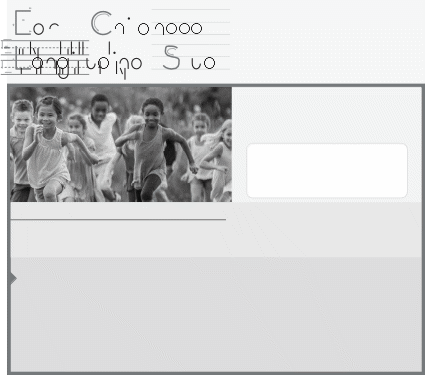




Link_ID
P |
|
|
Completing this survey will help us learn more about children and their experiences in different schools and classrooms.
Thank you for your time!
To show our appreciation, we have included with your invitation a check that equals $20 for the teacher background survey plus $7 for every child for whom you’ve been asked to complete a survey.
Please return the survey to your school coordinator or an ECLS staff member. The survey should be sealed in the envelope we provided you. Do not mail this survey unless you are provided with an additional mailing envelope.
Photo is for illustrative purposes only. Any person depicted in the photo is a model.
The
National
Center
for
Education
Statistics
(NCES)
is
authorized
to
conduct
the
Early
Childhood
Longitudinal
Study
(ECLS)
by
the
Education
Sciences
Reform
Act
of
2002
(ESRA
2002,
20
U.S.C.
§9543).
The
data
are
being
collected
for
NCES
by
Westat,
a
U.S.-based
research
organization.
All
of
the
information
you
provide
may
be
used
only
for
statistical
purposes
and
may
not
be
disclosed,
or
used,
in
identifiable
form
for
any
other
purpose
except
as
required
by
law
(20
U.S.C.
§9573 and 6 U.S.C. §151). According to the Paperwork
Reduction Act of 1995, no persons are required to respond to a
collection of information unless it
displays
a valid OMB control number. The valid OMB control number for this
voluntary information collection is 1850-0750 v.24. The time
required to complete
this
information collection is estimated to average approximately 16
minutes per child-level survey including the time to review
instructions and complete and
review
the
information
collection.
If
you
have
any
comments
concerning
the
accuracy
of
the
time
estimate,
suggestions
for
improving
this
information
collection,
or
any comments or concerns regarding the status of your individual
submission of these data, please write directly to: Early Childhood
Longitudinal Study,
National
Center
for
Education
Statistics,
PCP,
550
12th
St.,
SW,
4th
floor,
Washington,
DC
20202.
OMB
No.
1850-0750,
v.24.
Approval
expires
xx/xx/xxxx
TQCFK-FT


Early Childhood Longitudinal Study Kindergarten Teacher Survey (Child Level)
Fall 2022 - Form TQCFK-FT
INTRODUCTION
Dear Teacher,
Your school has agreed to participate in the Early Childhood Longitudinal Study (ECLS), a nationwide study of elementary-aged children, their schools, teachers, and parents. As part of the study, we are asking teachers at your school to complete surveys. You have been asked to complete this survey because one or more of the children in your class(es) are participants in this study. The child who is the subject of this survey is identified on the cover. This survey contains questions about this child’s skills and abilities.
The ECLS collects information from teachers of children who are in the study to investigate the relationship between children’s academic progress and various school, classroom, teacher, and home characteristics.
Taking part in the study is voluntary. You may stop at any time or choose not to answer a question you do not want to answer. However, only you can provide this information.
Although we realize you are very busy, we urge you to complete this survey as completely and accurately as possible.
THANK YOU VERY MUCH FOR YOUR HELP.

 TQCFK-FT
TQCFK-FT
MARKING DIRECTIONS

PLEASE READ CAREFULLY AND USE A BLACK OR BLUE BALL POINT PEN TO COMPLETE THIS SURVEY. DO NOT USE PENCIL OR FELT-TIP PEN.

It is important that you mark an “X” in the box next to your answers and print clearly.
Shown below is the correct way to mark your answers, along with examples of incorrect ways.
Correct Mark:
![]()
Incorrect Marks:



Light
and thin, outside
the box,
thick or
scrawled.
How to Change an Answer:
Completely black out the box of the incorrect answer and mark an “X” in the box next to the correct answer.
![]()




Answers should be printed clearly and
should not touch or cross any of the box lines. Do not
cross zeroes or sevens. That
is, do not write a zero with a line through it like this – 0,
and do not
write
a
seven with a
line
through it
like
this
–
7.
Write one number per box like this:
1
2
3
4
5
6
7
8
9
0









Write words like this:
John Smith

TQCFK-FT


ACADEMIC RATING SCALE
First, we would like for you to rate this child's current skills, knowledge, and behaviors within language and literacy (section 1), science (section 2), and mathematical thinking (section 3), based on your experience with him or her. If you are not the primary teacher in any of these areas, you may want to consult with the person most familiar with the child’s progress in the area when completing the scales.
 This
is NOT
a test
and should
NOT be
administered directly
to the child.
This
is NOT
a test
and should
NOT be
administered directly
to the child.
 Examples
are meant to help you think of the range of situations in which the
child may demonstrate the
identified skills
and behaviors.
These examples
do not
exhaust all
the ways
the child
may
demonstrate
what he or she knows or can do. The examples do,
however, indicate a level of proficiency a child should
have reached in order to receive the highest ratings. Some of
these examples describe a very high level of
performance (beyond typical students) in order to evaluate
achievement levels of the highest performing
students.
Examples
are meant to help you think of the range of situations in which the
child may demonstrate the
identified skills
and behaviors.
These examples
do not
exhaust all
the ways
the child
may
demonstrate
what he or she knows or can do. The examples do,
however, indicate a level of proficiency a child should
have reached in order to receive the highest ratings. Some of
these examples describe a very high level of
performance (beyond typical students) in order to evaluate
achievement levels of the highest performing
students.
 Rate
this child
compared to
other children
of the
same age
level. Please
consider the
full range
of ratings
when answering.
Rate
this child
compared to
other children
of the
same age
level. Please
consider the
full range
of ratings
when answering.
The following five-point scale is used for each of the questions. It reflects the degree to which a child has acquired and demonstrated the targeted skills, knowledge, and behaviors. Please review the definitions before turning to the next page.
Not yet Beginning
In progress Intermediate Proficient
Not applicable or Skill not yet taught
= Child has not yet demonstrated skill, knowledge, or behavior.
= Child is just beginning to demonstrate skill, knowledge, or behavior but does so very inconsistently.
= Child demonstrates skill, knowledge, or behavior with some regularity but varies in level of competence.
= Child demonstrates skill, knowledge, or behavior with increasing regularity and average competence but is not completely proficient.
= Child demonstrates skill, knowledge, or behavior competently and consistently.
= Skill, knowledge, or behavior has not been introduced in classroom setting.
If this child has limited English proficiency or is an English language learner, answer with his or her native language in mind if he or she does not yet demonstrate skills in English but does demonstrate them in his or her native language.
If this child has a disability, it may be necessary to consider adaptations for some questions to make them more inclusive for this child's skills and/or use of adaptive equipment. Some children may utilize alternative forms of verbal communication (for example, sign language, communication boards) or written communication (for example, word processors, Braille, dictation). Please answer the questions with these adaptations in mind.




20
TQCFK-FT
SECTION 1: LANGUAGE AND LITERACY
A1.
First, please rate this child's current skills, knowledge, and behaviors in LANGUAGE AND LITERACY.
MARK ONE RESPONSE ON EACH ROW.
Not
THIS CHILD...
Contributes relevant information to classroom discussions – for example, during a class discussion, can express an idea or a personal opinion on a topic and the reasons behind the opinion.
Engages in higher-level thinking and reasoning during classroom discussions – for example, answers questions that are not just an explicit recall of facts, makes inferences, asks
on-topic questions, and can have a cohesive exchange of ideas that are centered on a given topic for at least three conversational turns.
Uses correct endings on verbs and nouns when speaking – for example, says "dog plays" and "dogs play" or uses present tense ("she runs" or "she is running") and past tense correctly for both regular and irregular verbs ("he walks" and "he walked"; "I run" and "I ran").
Uses morphemes to figure out the meanings of words – for example, knows that “–s” means “more than 1” as in “trucks”; “–er” means a “person who” as in “farmer” and “painter”; “un” means “not” as in “unlike” and “unfriendly”; or “re” means “again” as in “reread” and “replay.”
Uses morphemes to decode new words – for example, decodes “jellyfish” by recognizing it is made up of two familiar words “jelly” and “fish” or decodes “preheat” as “pre” and “heat” and “fearless” as “fear” and “less.”
Uses complex sentence structures – for example, says "If she had brought her umbrella, she wouldn't have gotten wet," or "Yesterday it was raining cats and dogs," or "Why can't we go on the field trip at the same time as the first grade?"
Understands and interprets a story or other text read to him/her – for example, by retelling a story just read to the group, or telling about why a story ended as it did, or connecting part of the story to his/her own life.
Not yet



Beginning



In progress



Intermediate



Proficient



applicable or
Skill not
yet taught



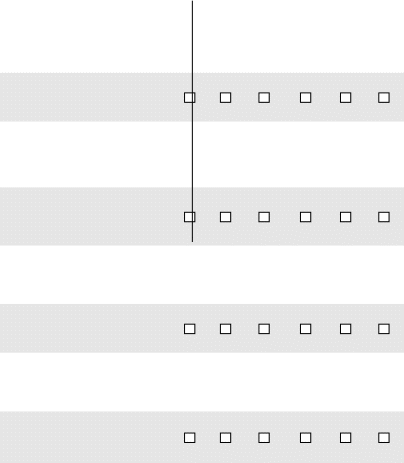


 1 TQCFK-FT
1 TQCFK-FT
A1. (Cont.) Please rate this child's current skills, knowledge, and behaviors in LANGUAGE AND LITERACY.
MARK ONE RESPONSE ON EACH ROW.
THIS CHILD...
Easily and quickly names all upper- and lower-case letters of the alphabet.
Predicts what will happen next in stories
by using the pictures and storyline for clues.
Reads simple books independently – for example, reads books with a repetitive language pattern.
Demonstrates early writing behaviors – for example, by using initial consonants to spell words ("d" for the word "dog"), or using letter names to represent sounds ("r" for the word "are"), or phonetic spelling ("hrt") for the word "heart," to convey words or ideas.
Composes simple stories – for example, by writing about a personal experience in a journal.
Not yet


Beginning


In progress


Intermediate


Proficient


Not applicable or
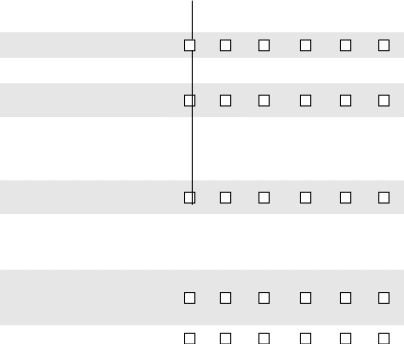 Skill
not
Skill
not
yet taught


Composes informative/explanatory text – for example, uses a combination of drawing, dictating, and writing to state what is being written about, supply some information about the topic, and provide some sense of closure.





 Demonstrates
an understanding
of some
Demonstrates
an understanding
of some
of the conventions of print – for example, by using both upper- and lower-case letters when writing, or putting spaces between words, or using a period at the end of a sentence.
Finds meaningful units in words such as prefixes, suffixes, and base words.
SECTION 2: SCIENCE
B1. Next, please rate this child's current skills, knowledge, and behaviors in SCIENCE.
MARK ONE RESPONSE ON EACH ROW.
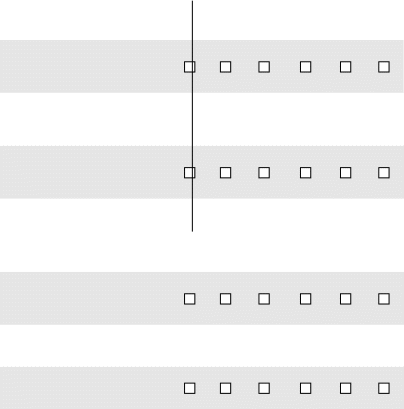 Not
applicable
or
Not
applicable
or
Skill not
THIS CHILD...
Uses his/her senses to explore and observe – for example, observes and notes the habits of classroom pets, or describes the differences in clay before and after water is added.
Forms explanations based on observations and explorations – for example, describes or draws the conditions (water, soil, sun) that help a plant grow, or explains that a block will slide more quickly down a steeper slope.
Classifies and compares living and non-living things in different ways – for example, classifies objects according to "things that are alive and not alive," or "things that fly and things that crawl."
Directly compares two objects with a measurable attribute in common to see which object has “more of”/”less of” the attribute and describes the difference – for example, directly compares the heights of two children and describes one child as taller/shorter.
Makes logical predictions when pursuing scientific investigations – for example, observes and identifies patterns in nature and predicts what happens next (for example, predicts if a new object will float or sink).
Communicates scientific information – for example, records or describes the properties of common objects verbally or through drawings or graphs.
Shows curiosity about the world by asking how and why things happen – for example, asks how rocks are formed or why it is warmer in the daytime than at night.
Not yet



Beginning



In progress



Intermediate



Proficient



yet taught



B1.
(Cont.) Please rate this child's current skills, knowledge, and behaviors in SCIENCE.
 MARK
ONE
RESPONSE
ON
EACH
ROW.
MARK
ONE
RESPONSE
ON
EACH
ROW.






SECTION 3: MATHEMATICAL THINKING
C1.
Now, please rate this child's current skills, knowledge, and behaviors in MATHEMATICAL THINKING.
MARK ONE RESPONSE ON EACH ROW.
Not
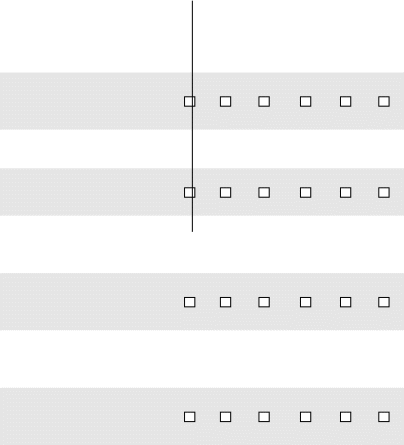
THIS CHILD...
Counts forward beginning from a given number within the known sequence, instead of having to begin at 1 – for example, child starts with 5 objects and is given 2 more and child counts “6, 7” instead of “1, 2, 3, 4, 5, 6, 7” to get the answer of 7.
Orders a group of objects – for example, by ordering rods or sticks by length, or arranging paints from lightest to darkest or musical instruments from softest to loudest.
Shows an understanding of the relationship between quantities – for example, knows that a group of ten small stones is the same quantity as a group of ten larger blocks.
Demonstrates consistent understanding of one-to-one correspondence – for example, when counting objects, says the number names in the standard order, pairing each object with one and only one number name and each number name with one and only one object.
For any number from 1 to 9, finds the number that makes 10 when added to the given number (for example, by using objects or drawings) and records the answer with a drawing or equation (for example, 3 + _ = 10 and 4 + _ = 10).
Uses place value to compose and decompose numbers from 11 to 19 into tens and ones (for example, by using objects or drawings) and records each composition or decomposition by a drawing or equation (for example, 18 = 10 + 8).
Solves problems involving numbers using concrete objects – for example, "Vera has six blocks, George has three, how many blocks are there in all?" or “How many do I need to give George so he will have the same number of blocks as Vera?"
Not yet



Beginning



In progress



Intermediate



Proficient



applicable or
Skill not
yet taught



C1.
(Cont.) Please rate this child's current skills, knowledge, and behaviors in MATHEMATICAL THINKING.
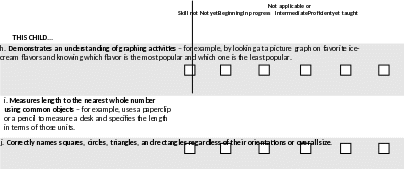 MARK
ONE
RESPONSE
ON
EACH
ROW.
MARK
ONE
RESPONSE
ON
EACH
ROW.






SECTION 4: EARLY LANGUAGE SKILLS
D1.
For this set of questions, please focus on this child’s early language skills in English based on your experience with this child at school. Think about your experience with this child at school. Mark the response option that best indicates how often this child exhibits the following early language skills when at school. Your best guess is fine. MARK ONE RESPONSE ON EACH ROW.
How Often?
THIS CHILD... Never Rarely
 Recalls
and communicates personal experiences
he/she
has
had
to peers
in
a
logical
way.
Recalls
and communicates personal experiences
he/she
has
had
to peers
in
a
logical
way.
 Answers
questions that are not just an explicit
recall of
facts but that require some higher-level
thinking.
Answers
questions that are not just an explicit
recall of
facts but that require some higher-level
thinking.
Some-
times Often


Very
often








d. Uses
a varied vocabulary
in spoken
language.
Uses grammatically correct sentences when speaking.





 Recalls
and communicates the meaning of a
story or other
experiences/events which he/she
has
heard.
Recalls
and communicates the meaning of a
story or other
experiences/events which he/she
has
heard.



 Uses
correct endings on verbs and nouns when
speaking –
for example, says “dog plays” and
“dogs
play” or uses present tense (“she runs” or
“she is
running”) and past tense correctly for
both
regular
and
irregular
verbs
(“he
walks”
and
“he
walked”; “I
run”
and “I
ran”).
Uses
correct endings on verbs and nouns when
speaking –
for example, says “dog plays” and
“dogs
play” or uses present tense (“she runs” or
“she is
running”) and past tense correctly for
both
regular
and
irregular
verbs
(“he
walks”
and
“he
walked”; “I
run”
and “I
ran”). Asks
on-topic questions that are relevant to the
discussion
in
the classroom.
Asks
on-topic questions that are relevant to the
discussion
in
the classroom.










Uses complex sentences with two or more clauses of various types (for example, independent, dependent) in spoken language, rather than using only simple, short sentences with a subject and a verb.
l. Instructs peers in tasks which need to be done in a certain order.

D1. (Cont.) For this set of questions, please focus on this child’s early language skills in English based on your experience with this child at school. Think about your experience with this child at school. Mark the response option that best indicates how often this child exhibits the following early language skills when at school. Your best guess is fine. MARK ONE RESPONSE ON EACH ROW.
How Often?
THIS CHILD... Never Rarely
Some-
times Often
Very
often





 Tries
repeatedly to communicate information
which
has
not
been
understood.
Tries
repeatedly to communicate information
which
has
not
been
understood. Uses
evidence from a text or word problem to
support his
or
her
answer.
Uses
evidence from a text or word problem to
support his
or
her
answer.



 Uses
morphemes to
figure out the meanings of
words
– for
example, knows that “–s” means
“more
than 1” as in “trucks”; “–er”
means a
“person
who” as in “farmer” and “painter”;
“un”
means “not”
as in “unlike” and “unfriendly”; or
“re”
means “again” as
in “reread”
and
“replay.”
Uses
morphemes to
figure out the meanings of
words
– for
example, knows that “–s” means
“more
than 1” as in “trucks”; “–er”
means a
“person
who” as in “farmer” and “painter”;
“un”
means “not”
as in “unlike” and “unfriendly”; or
“re”
means “again” as
in “reread”
and
“replay.” Uses
long sentences with descriptive language
and connecting
words in a grammatically
appropriate
way
when speaking.
Uses
long sentences with descriptive language
and connecting
words in a grammatically
appropriate
way
when speaking.





Asks questions about information which is unclear to him/her.
u. Tries out new words (for example, heard in stories or from teacher) when speaking.










 Relates
and communicates personal experiences
in a
logical
way or
“in a
way
that
makes sense."
Relates
and communicates personal experiences
in a
logical
way or
“in a
way
that
makes sense." Uses
descriptive vocabulary such as adjectives
and/or
adverbs
when speaking
to
provide
detail.
Uses
descriptive vocabulary such as adjectives
and/or
adverbs
when speaking
to
provide
detail.



 Rephrases
questions or asks follow-up questions
if he/she does
not get the information he/she
wanted.
Rephrases
questions or asks follow-up questions
if he/she does
not get the information he/she
wanted. Uses
morphemes to
decode new words
– for
example,
decodes “jellyfish” by recognizing it is
made up of two
familiar words “jelly” and “fish”
or
decodes
“preheat”
as
“pre”
and “heat”
and
“fearless”
as
“fear”
and
“less."
Uses
morphemes to
decode new words
– for
example,
decodes “jellyfish” by recognizing it is
made up of two
familiar words “jelly” and “fish”
or
decodes
“preheat”
as
“pre”
and “heat”
and
“fearless”
as
“fear”
and
“less."
D1. (Cont.) For this set of questions, please focus on this child’s early language skills in English based on your experience with this child at school. Think about your experience with this child at school. Mark the response option that best indicates how often this child exhibits the following early language skills when at school. Your best guess is fine. MARK ONE RESPONSE ON EACH ROW.
How Often?
THIS CHILD... Never Rarely
Some-
times Often
Very
often





 bb.
Actively contributes
within a
classroom discussion.
bb.
Actively contributes
within a
classroom discussion.

D2.
Next, please think about this child's written language. Which of the following writing levels (ordered below from lowest to highest) best describes the highest level at which this child is currently performing (independently, without teacher help)? MARK ONE RESPONSE.


 Scribbling
Drawing a
picture
Scribbling
Drawing a
picture
Can copy his or her name


 Can
copy sentences from the board
Write his
or her name
without copying
Can
copy sentences from the board
Write his
or her name
without copying

 Can
write most letters when asked to write the letter
Write initial
sounds for
many words
Can
write most letters when asked to write the letter
Write initial
sounds for
many words
Write simple 2-4 letter words with invented spelling


 Write
multi-syllabic words
with invented
spelling with
most sounds
represented Compose
and write
a full
sentence with
invented spelling
with most
sounds represented
Write
multi-syllabic words
with invented
spelling with
most sounds
represented Compose
and write
a full
sentence with
invented spelling
with most
sounds represented
Compose and write 2 or more consecutive full sentences with invented spelling with most sounds represented
 Other
(Please specify):
Other
(Please specify):

D3. How much does this child enjoy writing? MARK ONE RESPONSE.




 Not
at all
A little bit Somewhat
Quite a bit Very
much
Not
at all
A little bit Somewhat
Quite a bit Very
much
SECTION 5: SOCIAL SKILLS AND APPROACHES-TO-LEARNING
E1.
For this set of items, please think about this child's behavior during the past month or two. Decide how often the child demonstrates the behavior described. MARK ONE RESPONSE ON EACH ROW.
Never Sometimes Often
Very often
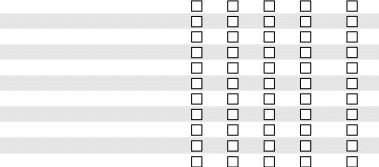 No
opportunity
No
opportunity
→ Child never exhibits this behavior.
→ Child exhibits this behavior occasionally or sometimes.
→ Child exhibits this behavior regularly but not all the time.
→ Child exhibits this behavior most of the time.
→ No opportunity to observe this behavior.
-
How Often?
Some- Very
Never times Often often
No opportunity
to observe
a. Xxxxxxxxxxxxxxxxxx.





b. Xxxxxxxxxxxxxxxxxxxxxx
c. Xxxxxxxxxxxx
d. Xxxxxxxxxxxxxxxxxx
e. Xxxxxxxxxxxxxxxxxxxxxxxxxxxx
f. Keeps belongings organized.
g. Xxxxxxxxxxxxxxxxxxxxxxxxxxx
h. Shows eagerness to learn new things.
i. Works independently.
j. Xxxxxxxxxxxxxxxxx
k. Xxxxxxxxxxxxxxxxxxx
l. Easily adapts to change in routines.
m. Xxxxxxxxxxxxxxxxxxxxxx





n. Persists in completing tasks.





o. Pays attention well.





p. Follows classroom rules.





q. Xxxxxxxxxxxxxxxxxxxxxxxxxxxxxxxxxxxxxxx





r. Xxxxxxxxxxxxxxxxxxxxxxxxxxx





s. Xxxxxxxxxxxxxxxxxxxxxxxx





Source: Social Skills Rating System (SSRS). Copyright © 1990, NCS Pearson. Adapted with permission. All rights reserved; Social Skills Improvement System (SSIS). Copyright © 2008, NCS Pearson. Adapted with permission. All rights reserved.
E1.
(Cont.) For this set of items, please think about this child's behavior during the past month or two. Decide how often the child demonstrates the behavior described. MARK ONE RESPONSE ON EACH ROW.
Never Sometimes Often
Very often
No opportunity
→ Child never exhibits this behavior.
→ Child exhibits this behavior occasionally or sometimes.
→ Child exhibits this behavior regularly but not all the time.
→ Child exhibits this behavior most of the time.
→ No opportunity to observe this behavior.

Source: Social Skills Rating System (SSRS). Copyright © 1990, NCS Pearson. Adapted with permission. All rights reserved; Social Skills Improvement System (SSIS). Copyright © 2008, NCS Pearson. Adapted with permission. All rights reserved.
SECTION 6: CLASSROOM BEHAVIORAL REGULATION
F1.
Now we would like you to think about this child's behavior with other children and adults in the classroom and his or her work with materials. Select the response that best indicates the frequency this child exhibits the behavior described. MARK ONE RESPONSE ON EACH ROW.
-
Never
Rarely
Some-
times
Frequently/
Usually Always
a. Observes rules and follows directions without requiring repeated reminders.





b. Completes learning tasks involving two or more steps (for example, cutting and pasting) in organized way.





c. Completes tasks successfully.





d. Attempts new challenging tasks.





e. Concentrates when working on a task; is not easily distracted by surrounding activities.





f. Responds to instruction and then begins an appropriate task without being reminded.





g. Takes time to do his or her best on a task.





h. Finds and organizes materials and works in an appropriate place when activities are initiated.





i. Sees own errors in a task and corrects them.





j. Returns to unfinished tasks after interruption.





Source: Bronson, M. B., Goodson, B. D., Layzer, J. I., and Love, J. (1990). Child Behavior Rating Scale. Cambridge, MA: Abt Associates. Adapted and used with permission.
SECTION 7: CLASSROOM BEHAVIORS
G1.
For this set of items, please read each statement and decide whether it is a “true” or “untrue” description of this child’s reaction to a number of situations within the past six months. If you cannot answer one of the items because you have never seen this child in that situation, then select “not applicable."
MARK ONE RESPONSE ON EACH ROW.
When practicing an activity, has a hard time keeping her/his mind on it.
Extremely
untrue
Quite
untrue
Slightly
untrue
Neither true nor
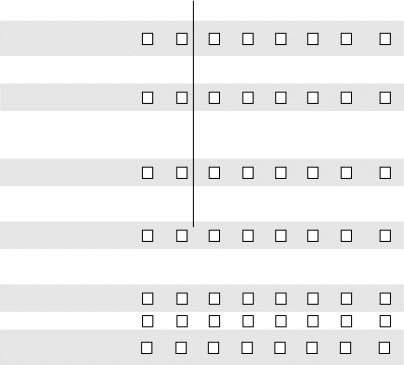 untrue
untrue
Slightly
true
Quite
true
Extremely
true
Not
applicable







 Will
move from one task to another
without
completing any of
them.
Will
move from one task to another
without
completing any of
them.When drawing or coloring in a book, shows strong concentration.







 When
building
or
putting
something
together,
becomes very involved in
what s/he is
doing, and works for
long
periods.
When
building
or
putting
something
together,
becomes very involved in
what s/he is
doing, and works for
long
periods.Is easily distracted when listening to a story.







 Sometimes
becomes
absorbed
in
a picture book
and looks at it for a
long
time.
Sometimes
becomes
absorbed
in
a picture book
and looks at it for a
long
time.Can wait before entering into new activities if s/he is asked to.







 Plans
for new activities or changes
in routine to
make sure s/he has
what will
be needed.
Plans
for new activities or changes
in routine to
make sure s/he has
what will
be needed.Has trouble sitting still when s/he is told to (story time, etc.).
Is good at following instructions.
Approaches places that s/he thinks might be "risky" slowly and cautiously.







 Can
easily stop an
activity
when
s/he
is told "no."
Can
easily stop an
activity
when
s/he
is told "no."
Source: Putnam, S. P., & Rothbart, M. K. (2006). Development of Short and Very Short forms of the Children's Behavior Questionnaire.
Journal of Personality Assessment, 87(1): 103-113. Used with permission.
SECTION 9: STRATEGIC PLANNING
I1.
Please read the statements below and indicate how often each applies to this child’s behaviors observed across the past month. MARK ONE RESPONSE ON EACH ROW.
Does not apply
Sometimes applies
Consistently applies

b. Xxxxxxxx xxx xxxx xx xxxxxxx xx xxxxxxxx




xxx
xx xxxxx xx xxxx xxxxxxxx xxxxxx xxx
xxxx xxx xxx.
d. Xxxxxxxxxx xxx xxxxxxxx xxxxxxxxxxxx xx




x
xxxxxxxxxx xxx xx xxxxx (xxx xxxxxxx, "Xx X
xxxx xxx xxxx,
xxxx xx xxx
xxx.").
f. Xxxxxxxx x xxxx xxx xxxxx-xxxx xxxxxxxx (xxx







xxxxxxx,
"Xxxxx, X'x xxxxx xx xxxx xx xxx
xxxx. Xxxx,
X xxxx
xxx xxx
xxxx xxx
xxxx xx.").
h. Xxxxxxx xxxxxxx xxxxx x xxx xxxx xx xxxxx.



 j. Xxxxxxxxxxxx
xxxx xxxxxxxx xxx xxxx xxxx
xxxx xxx
xxxxxxxxxx xxxxxxxx.
j. Xxxxxxxxxxxx
xxxx xxxxxxxx xxx xxxx xxxx
xxxx xxx
xxxxxxxxxx xxxxxxxx.
Source: Adapted from the Learning-to-Learn Scales © 2019 by Edumetric and Clinical Science. All rights reserved. Used with permission. McDermott, P. A. (2018). Learning-To-Learn Scales. Philadelphia: University of Pennsylvania and Edumetric and Clinical Science.
SECTION 11: STUDENT INFORMATION
K1.
In what type of program is this child enrolled? MARK ONE RESPONSE.
 Full-day
program
Full-day
program

 Morning
part-day program Afternoon
part-day program
Morning
part-day program Afternoon
part-day program
K2.
Is the 2022-23 school year this child's...? MARK ONE RESPONSE.
Kindergarten includes regular kindergarten, transitional (or readiness) kindergarten, transitional first (or pre-first) grade, or a program that is a kindergarten equivalent but is ungraded or has multiple grades.
A transitional kindergarten (TK) program is an extra year of school before kindergarten starts. It is different from preschool, Head Start, and prekindergarten.
Transitional first (or pre-first grade) is a school program between kindergarten and the first grade. It is for children who have attended kindergarten, but need more time to be ready for the first grade.


 First
year in kindergarten Second
year in
kindergarten
First
year in kindergarten Second
year in
kindergarten
Third year or more in kindergarten
K3.
How often does this child wear eye glasses or contact lenses in the classroom? MARK ONE RESPONSE.



 Never
Seldom
Usually Always
Never
Seldom
Usually Always
K4.
How many instructional groups based on achievement or ability levels in reading do you currently have in this child’s class? MARK ONE RESPONSE.


 I
do not
use instructional
groups for
reading
I
do not
use instructional
groups for
reading



 Two
Three Four
Two
Three Four
Five or more
K5.
In which reading instructional group is this child currently placed? USE "1" FOR THE HIGHEST INSTRUCTIONAL GROUP. ENTER IN THE NUMBER OF THE CHILD'S INSTRUCTIONAL GROUP BELOW.
 Instructional
Group
Instructional
Group
K6.
How many instructional groups based on achievement or ability levels in mathematics do you currently have in this child’s class? MARK ONE RESPONSE.


 I
do not
use instructional
groups for
mathematics
I
do not
use instructional
groups for
mathematics



 Two
Three Four
Two
Three Four
Five or more
K7.
K8.
K9.
In which mathematics instructional group is this child currently placed? USE "1" FOR THE HIGHEST INSTRUCTIONAL GROUP. ENTER IN THE NUMBER OF THE CHILD'S INSTRUCTIONAL GROUP BELOW.
 Instructional
Group
Instructional
Group
Are you this child's primary teacher in the following subject areas? MARK ALL THAT APPLY.
A primary teacher is the teacher who is responsible for all learning in that subject area. The primary teacher writes all lesson plans and handles all activities and assessments in that subject area. If you co-teach a subject area with another teacher, but think you could report about this child, please report that you are the child’s primary teacher for that subject area.


 Reading/Language
Arts Mathematics
Reading/Language
Arts Mathematics
 Science
Social Studies
Science
Social Studies
Please fill in the boxes below with the date the survey was completed.
2
0
2
2


MONTH DAY YEAR
Thank you very much for answering these questions and for taking the time to participate in the
Early Childhood Longitudinal Study.
| File Type | application/vnd.openxmlformats-officedocument.wordprocessingml.document |
| File Modified | 0000-00-00 |
| File Created | 0000-00-00 |
© 2025 OMB.report | Privacy Policy

